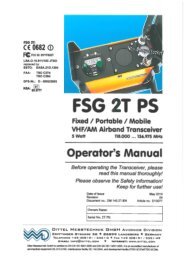EFIS-D6 Installation Guide
EFIS-D6 Installation Guide
EFIS-D6 Installation Guide
You also want an ePaper? Increase the reach of your titles
YUMPU automatically turns print PDFs into web optimized ePapers that Google loves.
Instrument <strong>Installation</strong><br />
PC CONNECTION FOR FIRMWARE UPDATES<br />
On the <strong>EFIS</strong> 25-pin wiring harness<br />
available from Dynon, there are three<br />
wires bundled together, terminating in a<br />
standard DB9-pin female connector. This<br />
cable is 6’ long and pre-assembled for<br />
connection to a PC-based laptop. Route<br />
this cable to a convenient location that can<br />
be accessed whenever you need to update<br />
your product’s firmware or checklists.<br />
<strong>EFIS</strong><br />
DB25<br />
Pin#<br />
If you did not purchase a harness from<br />
Dynon, obtain a 9-pin D-sub connector<br />
and make the three connections shown in the table.<br />
DB9<br />
Pin#<br />
Wire<br />
Color<br />
RS-232 Function<br />
9 5 Black Signal ground<br />
10 2 Orange <strong>EFIS</strong>-<strong>D6</strong> transmit /<br />
device receive<br />
22 3 Yellow <strong>EFIS</strong>-<strong>D6</strong> receive /<br />
device transmit<br />
To verify proper communication between the <strong>EFIS</strong>-<strong>D6</strong> and the PC, use the Dynon Support<br />
Program’s “Detect Firmware Version” function. Download the latest version of the Support<br />
Program at downloads.dynonavionics.com.<br />
GPS CONNECTION FOR AIRSPEED FAILOVER<br />
A yellow/green wire is spliced into the <strong>EFIS</strong> serial receive<br />
line. In the event of loss of airspeed data (e.g., via pitot<br />
icing), the <strong>EFIS</strong>-<strong>D6</strong> uses GPS groundspeed. This allows the<br />
<strong>EFIS</strong>-<strong>D6</strong>’s attitude to operate properly despite compromised<br />
airspeed accuracy. Connect this yellow/green wire to your<br />
GPS’s serial transmit line. See the table at right for GPSs<br />
known to work.<br />
To use the GPS-failover feature on your <strong>EFIS</strong>-<strong>D6</strong>, your GPS<br />
must output either “aviation format” or the $GPRMC and<br />
$GPGGA NMEA sentences in its serial stream. You must<br />
also have a supported cable that exposes your GPS’s serial<br />
transmit line. If you own a Garmin 430 or 530, in the<br />
UNITS/MAGVAR option, set the MAGVAR to AUTO.<br />
To verify your GPS connection, plug your pitot tube and taxi<br />
at a speed greater than 25 knots. If the GPS is properly<br />
connected, the alert GPS ASSIST is displayed on the attitude<br />
indicator. This verifies that, in the event of airspeed loss in<br />
flight, your GPS will be properly utilized for attitude<br />
calculation.<br />
GPS units known to work<br />
AvMap EKP-IV (v2.06.116R,<br />
NMEA set to “processed”)<br />
Bendix/King Skymap (set to<br />
AR NAV 9600 output)<br />
Garmin<br />
96, 96c, 150XL, 195, 196, 295,<br />
296, 396, 400, 420, 430,<br />
430W, 496, 500, 520, 530,<br />
530W, GX60, GX65<br />
Lowrance handhelds<br />
A frequently updated list of<br />
compatible GPS units and<br />
settings is available at our<br />
Documentation Wiki at<br />
wiki.dynonavionics.com.<br />
3-4 <strong>EFIS</strong>-<strong>D6</strong> <strong>Installation</strong> <strong>Guide</strong>
















